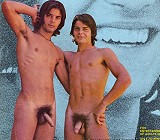Champions
Vol.1 No.1 May-July 1968
A brief look at the Greek lifestyle in the fourth and fifth centuries B.C. will give both an artistic and historical perspective on the Greek concept of beauty. From childhood on, every Greek boy was taught athletics in the tradition of his mentors. A finely formed body was of major importance within the Greek scheme of things.
The Greeks so worshipped beauty that, as we can see in their bas-reliefs and sculptures, they made it synonymous with goodness. Plato expressed the Greek way with his classic line, “From the love of the beautiful comes every good thing in heaven and earth. In his Republic, he wrote: “Virtue will be a kind of health and beauty and good habit of the soul, as vice will be a disease and a deformity of the soul.” Pericles — statesman, general and athlete — professed that men striving for the harmonious development of body and mind can win it by working for “the perfect beauty of our bodies and the manly virtues of our soul.” In one of his most memorable quotes, he said in an oration to the Athenians: “We are lovers of beauty without having lost the taste for simplicity, and lovers of wisdom without loss of manly vigor.”
The cultural milieu of ancient Greece was such that no man or boy was ashamed to admit to a consuming interest in beauty, its appreciation and its refinement. Instinctively the Greeks participated in the arts. Hoys painted, carved in stone, learned to play the flute and the lyre, to sing and to dance-Dancing was considered a form of athletics and. as such, was used to strengthen and tone up the body. Thus it is easy to see why many Greek dances were strenuous and often even warlike.
The Greek male exercised nude and wore no clothes in athletic events. It was only manly and straightforward to take pleasure in watching and even admiring the nude physiques of athletes. And a man or boy hadn’t the slightest fear of being called less than just that — a man or a boy it he said something like “Kalos pais — the boy is fair.” in rapt admiration of the miraculous work of art of which Greek athletes of the time were the embodiment.
At the same time, the Greeks considered the Persians and Egyptians among other cultures like them, to be effeminate for all their flowing robes, their mincing steps and constant use of perfumes. This only shows to point up the fact that what you think determines to a large degree what you are, and your concepts of “the beautiful and the good” (a Greek phrase) depend, of course, on your lifestyle the trappings of your culture, your knowledge, and social mores.
What’s m vogue, as it happens, is generally what everyone strives to imitate. The imitation doesn’t h§ve to be detrimental to the integrity of the individual. but it can be. For example, the typical Greek of early times would pity the poor boy brought up among Egyptians. Persians or Scythians. Imbued with the idea that the good life is to be lived by way of exotic clothes and cloying scents, the typical Egyptian boy must have looked on in amazement (if he ever had the opportunity) to see Greek soldiers practicing athletics, their oiled naked bodies glistening in the sun; or dancing, clad only in a bronze shield: or walking arm in arm, hand in hand.
Essentially, then, this is the difference between the two lifestyles, where in the one the naked male form was held to be both the symbol and the reality, the actual embodiment, of strength and virtue, innocence and vigor; and in the other, where the body is basically a hanger for long flowing robes, the symbols of status and refinement. It is precisely be cause of the Greek lifestyle, its adulation of “the good and the beautiful.” that whenever the naked male form is brought up either for discussion or study, for sense of direction the ideal has to be found in ancient Greece. “Nothing in excess” epitomized the concentration on the perfect balance, the proper exercise of mind and body.
Discipline was not easy. When boys became epheboi, teenagers, they were expected to learn the rules of running, jumping, throwing the javelin and the discus, dancing, chariot racing, boxing and wrestling.
Paintings from Greek vases and excerpts from the literature of the time let us know that the boys’ trainers were stern taskmasters. Any youth caught in faulty execution of a sport quickly felt the sting of his trainer’s whipstick.
Practiced daily and with concentration and devotion, the Greek boys’ curriculum soon became as much a part of their lives as eating and sleeping. The rewards of these exercises are obvious to anyone of any age who has ever followed a strict regimen for daily fitness. Along with increased ability to play sports and perform one’s daily routines, come self-confidence. poise and a healthy self-concept that generates from within, a glowing result of discipline and self improvement.
The Olympics were of course the final testing grounds for mental and physical excellence, the highest temporal reward for the attainment of ‘the good and the beautiful.” The Olympics were five days in duration, the first and last days of those five being reserved principally for ceremonies, the last day of course marked by much celebration and festive ceremonies. Held once every four years, the Festivals in the Valley of Olympia ended on the fifth day with a final sacrifice at the altar of Zeus and the awarding of prizes and awestruck admiration of their “beautiful and good” athletes from young and old alike.
Victors of the games were well aware that their honor carried with it weighty responsibility. Youngsters sought their advice on how to come to the same success. Parents and teachers — moral guardians — pointed to athletes as examples to their children and pupils of ‘ supreme beauty of body, mind and soul.”
A passage from Pindar that aptly expresses the essence of Olympic victory reads: “Before the gates of excellence, the high gods have placed sweat. Long is the road thereto and rough and steep. But when the height is achieved then is there duty so hard in keeping.”
Each new generation has always had a special predilection for looking back to “times when” and holding up to itself as a modern ideal whatever shapes and forms of the beautiful it can find in past cultures that exist today only in their lasting impact on the continuing story of man. Coming generations will continue to look back on the past, for in the past are to be found experience, wisdom and often beauty, sometimes a primitive beauty, sometimes a classical beauty, but always a beauty enhanced by the intangible aura of “the good days.” From the beginning of time, one of man’s main preoccupations has been with beauty. The human eye tries to find proportion in nature, handsomeness in design and form and goodness in person-to-person relations. The naked male figure is no more and no less than a part of beauty in existence.
1968




